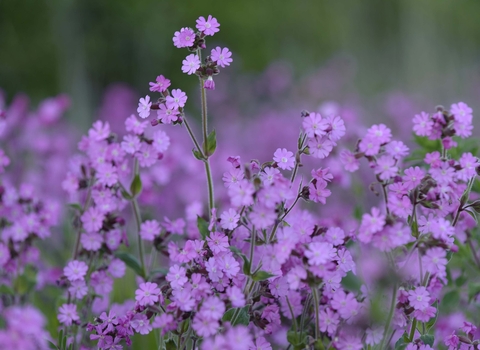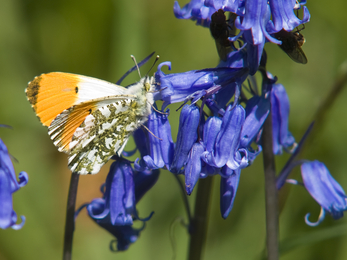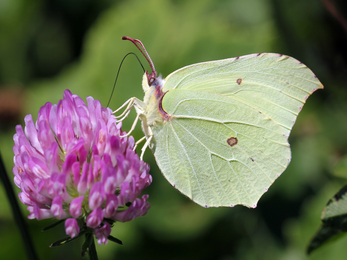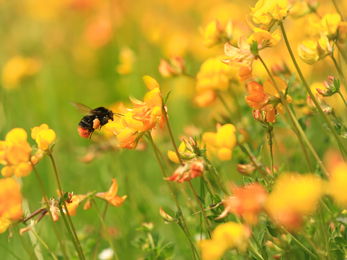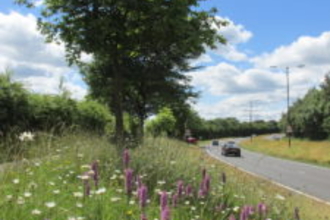We want to see a ribbon of wildflowers running alongside roads, and on roundabouts; supporting crucial pollinators like bees and butterflies. Small changes, such as mowing later in summer make a big contribution to putting nature on the road to recovery. Thousands of miles of road verges need to become a key part of an essential national Nature Recovery Network, connecting town and countryside, and joining up vital places for wildlife.
The Wildlife Trusts
New best practice grassland verge guidance
Grass verges and roadside nature reserves can be an oasis for nature. Wildlife Trusts work with highways authorities, councils and landowners to advise and help manage road verges. We’ve worked collaboratively with partners including Plantlife and Butterfly Conservation on this new guide which has step by step details on the best way to manage grass verges for wildflowers and pollinators.
In September 2019, The Wildlife Trusts organised a symposium with partners Butterfly Conservation and Natural England on 'Managing road-side verges for biodiversity in times of austerity'. The proceedings are available here.
Why manage road verges?
Road verges are home to almost half of the UK’s wildflower species (that’s 720 different flowers), from the vibrant white oxeye daisies brightening motorways and junctions, to the red campion, bluebells and lesser celandines adding colour to country lanes. In turn these flowers are home to hundreds of species of pollinators, from beetles to bumblebees.
Across the UK there are around 300,000 miles of road verge, which, if managed for wildlife while keeping road safety in mind, can provide a huge network of corridors and refuges for nature. Added together, road verges create an enormous area of land (over 200,000ha – about the size of Nottinghamshire) that cannot be put to any other use, providing a great opportunity to build a network of vital wildlife habitat.
Road verges support an amazing diversity of plants and animals and often have archaeologically-important old banks, ditches and hedgerows associated with them. Many road verges are home to remnants of once widespread flowers found in meadows, fenlands and farmland long since lost as land-use has changed and farming has become more industrial. Road verges are particularly important during the spring and summer when a huge range of wildflowers and grasses provide a rich habitat for wildlife including insects, spiders, snails, small mammals and birds.
While some road verges – particularly at junctions, certain bends or on busy roads – need to be cut for driver and pedestrian safety, many can simply be left to grow and remain uncut until late summer when seeds have set and insects have benefitted from the nectar and pollen. On broader verges it is important not to touch the 1-2m of ‘back verge’ until after bird nesting season, and then only to top it in most years without removing important cover for small mammals.
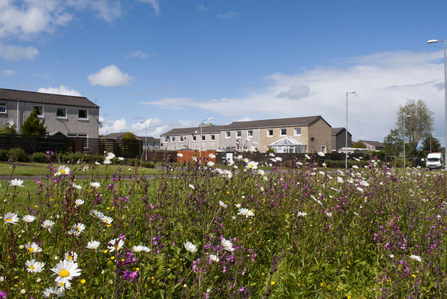
Wildflower verge ©Katrina Martin / 2020VISION
Where do we start?
You can begin growing road verges straight away. However, knowing what is living there will help gain support for your work, and show others what you are protecting and nurturing.
Surveys
Before you begin any conservation management on a road verge, assess what plants and animals are currently growing and living on it. This will help you work out what management might be best across your site, while avoiding disturbance to rare or protected species, such as orchids. You should also check with the road verge owner before you begin any work. Contact the Highways team at your local council or you could check with your local Wildlife Trust. Naturally, some road verges are easier to survey than others, with some being inaccessible for such survey work. Keep in mind your own safety and that of others, remain visible with high visibility vests or jackets, and only survey verges where it is safe to do so.
Who can help you do this?
There are likely to be skills and local knowledge within nearby wildlife groups, and individual naturalists and ecologists. You could also upskill yourself and/or your team by going on identification courses offered by Wildlife Trusts or other organisations.
What species are particularly vulnerable?
All plants and animals are protected under the Wildlife and Countryside Act 1981, and some plants, such as Deptford pink and particular species of orchids (for example, lizard orchids), are further protected from being picked, uprooted or destroyed.
Many birds nest between March and September, although most will be nesting in hedgerows and bushes adjacent to road verges. However, some birds such as blackcaps, chiffchaffs, willow warblers and robins will nest on the ground, or very close to the ground amongst nettles and other road verge plants. As mentioned in the previous section, on broader verges it is important not to touch the 1-2m of ‘back verge’ until after bird nesting season, and then only to top it in most years without removing important cover for small mammals.
If you are keen to cut a road verge and unsure whether there are bird nests still in occupation, contact local British Trust for Ornithology (BTO) county representatives. They might be able to suggest a nest recorder who can check the verges for any nests. The BTO also offer nest recording training courses. Alternatively, watch for birds making regular visits to a particular area of vegetation, although the nest itself may be in a different place to where the birds enter.
How can we manage our road verges?
Cutting
Cutting at the wrong time – for example, from early spring – can cause considerable harm to the wildlife in verges, as many wildflowers will not have a chance to flower or set seed and habitats are destroyed in the process. However, many verges are choked with lush, tall-growing grasses and tall, competitive plants like thistles, hogweed, cow parsley, docks and nettles which leave no room for anything else. As a general rule, where growth is not lush, tall and limited to just a few common plants, delay the cutting until later in the year, ideally from August onwards. This allows wildflowers the chance to grow and set their seed, and gives wildlife time to make the most of the habitat.
Specific advice on when and how to cut is set out in ‘Managing grassland road verges – a best practice guide". Given the different contexts of verge habitats it may be advisable to seek additional advice from an ecologist or local Wildlife Trust with the knowledge of local grassland and other habitats.
Signage
A sign stating that the site is not being cut until late summer, or even a specific date, can inform and reassure people that the site is managed and not being left to overgrow. Some road verges might be declared nature reserves, and involve volunteers maintaining the verges for wildlife.
Further information
Plantlife et al 2019 Managing grassland road verges – A best practice guide
Plantlife. The Good Verge Guide
DEFRA. Transport Corridor: Tailored advice on managing land for pollinators
Atherdon, M. and Sykes, N. 2012. Wild Flowers on the Edge: The Story of North Yorkshire’s Road Verges. PLACE publishers.
A home for wildlife
Road verges provide homes for species such as:

